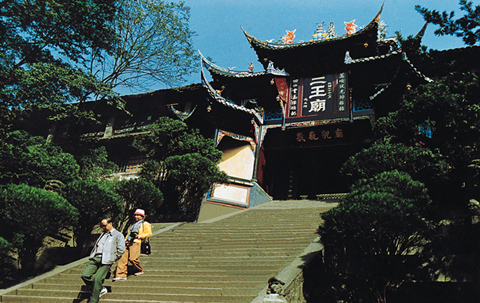Quake-damaged heritage buildings restored
After being damaged by Sichuan earthquake in 2008, cultural heritage buildings in Dujiangyan City are being restored and will be finished in September this year. The reconstruction work is being carried out by scholars and professional workers from all over China. The central government has invested 95 million yuan to date.
|
Erwang Temple before the earthquake |
Dujiangyan City is located to the northwest of Chengdu and 17.5 miles from Yingxiu, the epicenter of the earthquake happened on May 12, 2008. It has about 2,000 years of history and is known to the world for Dujiangyan dam, built in Qin Dynasty and Erwang Temple and Fulong Temple , which are located on the east side of Minjiang River and fell apart in the massive quake.
Scholars went to inspect the damage on the second day of the earthquake. They provided a report on May 18 and the restoration project began in June, 2008. About 400 workers from the cultural heritage protection bureaus of Guangxi and Fujian Provinces participated in the reconstruction. Liaoning Non-Ferrous Foundation Engineering Corporation is in charge of building foundation of the temples. The designers are from Cultural Heritage Protection Research Center of Beijing Tsinghua Urban Planning and Design Institute.
According to Fan Tuoyu, head of Dujiangyan Cultural Heritage Bureau, the project includes two phases. The first phase is strengthening foundation of heritage buildings to protect them from natural disasters such as earthquake and flood. The second phase is repairing the falling buildings. The restoration of Fulong Temple has been completed and 50 percent of the repair work of Erwang Temple has been finished.
The strengthening phase includes two parts. The first one is to lay a solid foundation below the temples to prevent them from sliding into the river if massive earthquake and flood happen at the same time. Workers build 72 of concrete pillars from 17m to 23m to sustain the unstable platform where Erwang Temple and other buildings sit. The second part is to restore the temples in traditional way. "We will correct some mistaken design made in the past few years and use traditional Chinese wooden structure. The traditional design can protect the buildings from earthquake very well." Fan said to China.org.cn.
The repairing phase will also be done in accordance with its original design. The workers choose to use a type of biological paint collected from local trees instead of the chemical one. Though it will cost more time and money, it can keep the color and luster of buildings for a longer time. All the wood used in the temples has been dried and soaked in antiseptic to protect it from the humid weather in Dujiangyan.
Countless difficulties occurred during the process. For example, the new design could not come out in a short time. So workers and scholars often discussed how to restore a certain part of the temples without design. The lack of detailed historical reference is another problem. China Photographers Association contributed hundreds of photos of Erwang Temple. "We used the original materials as many as possible." Fan smiled. "Relatives and friends of mine think we have done a good deed to restore the temples."
 0
0 







